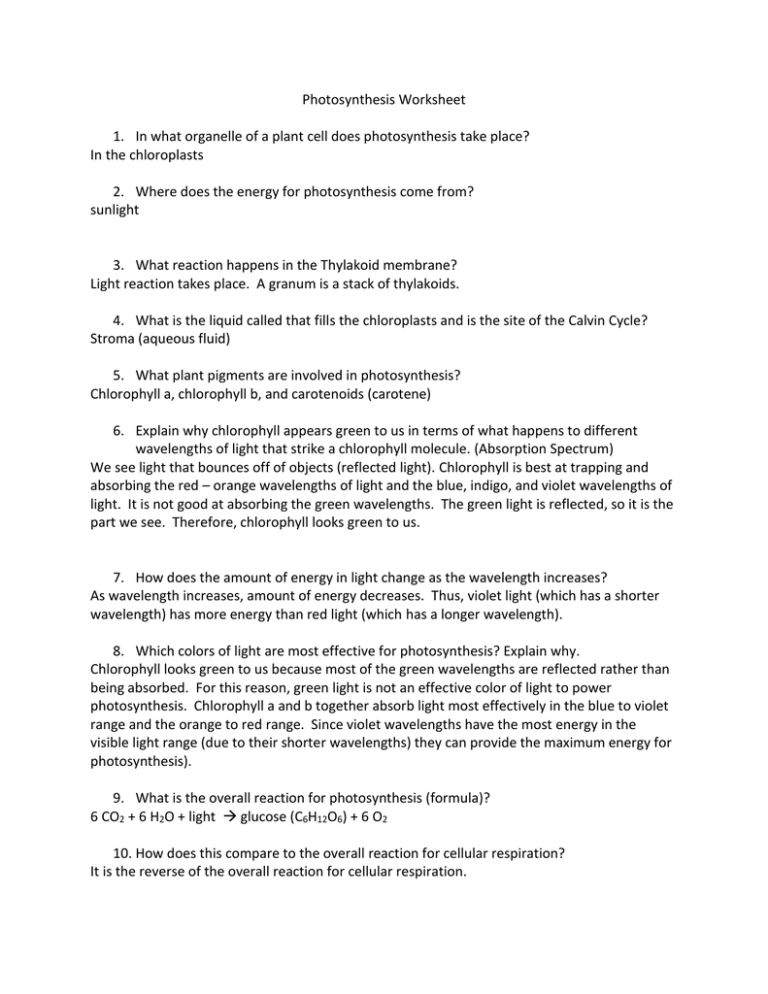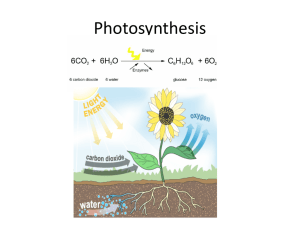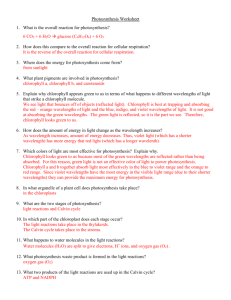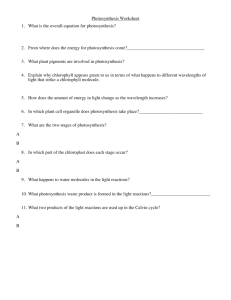Photosynthesis Worksheet
advertisement

Photosynthesis Worksheet 1. In what organelle of a plant cell does photosynthesis take place? In the chloroplasts 2. Where does the energy for photosynthesis come from? sunlight 3. What reaction happens in the Thylakoid membrane? Light reaction takes place. A granum is a stack of thylakoids. 4. What is the liquid called that fills the chloroplasts and is the site of the Calvin Cycle? Stroma (aqueous fluid) 5. What plant pigments are involved in photosynthesis? Chlorophyll a, chlorophyll b, and carotenoids (carotene) 6. Explain why chlorophyll appears green to us in terms of what happens to different wavelengths of light that strike a chlorophyll molecule. (Absorption Spectrum) We see light that bounces off of objects (reflected light). Chlorophyll is best at trapping and absorbing the red – orange wavelengths of light and the blue, indigo, and violet wavelengths of light. It is not good at absorbing the green wavelengths. The green light is reflected, so it is the part we see. Therefore, chlorophyll looks green to us. 7. How does the amount of energy in light change as the wavelength increases? As wavelength increases, amount of energy decreases. Thus, violet light (which has a shorter wavelength) has more energy than red light (which has a longer wavelength). 8. Which colors of light are most effective for photosynthesis? Explain why. Chlorophyll looks green to us because most of the green wavelengths are reflected rather than being absorbed. For this reason, green light is not an effective color of light to power photosynthesis. Chlorophyll a and b together absorb light most effectively in the blue to violet range and the orange to red range. Since violet wavelengths have the most energy in the visible light range (due to their shorter wavelengths) they can provide the maximum energy for photosynthesis). 9. What is the overall reaction for photosynthesis (formula)? 6 CO2 + 6 H2O + light glucose (C6H12O6) + 6 O2 10. How does this compare to the overall reaction for cellular respiration? It is the reverse of the overall reaction for cellular respiration. 11. What are the two stages of photosynthesis? Light reactions and Calvin cycle 12. In which part of the chloroplast does each stage occur? The light reaction takes place in the thylakoids The Calvin Cycle takes place in the stroma. 13. What two products of the light reactions are used up in the Calvin cycle? ATP and NADPH 14. What happens to water molecules in the light reactions? Water molecules (H2O) are split to give electrons, H+ ions, and oxygen gas (O2) 15. What photosynthesis waste product is formed in the light reactions? Oxygen gas (O2) 16. What is photorespiration? Only occurs when there is not enough carbon dioxide (CO2). Plants lose because oxygen then jumps into the Calvin Cycle producing another chemical that has no purpose and the plant has to break it down.







